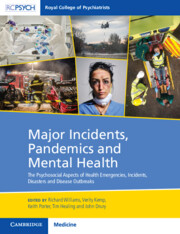 Major Incidents, Pandemics and Mental Health
Major Incidents, Pandemics and Mental Health Book contents
- Major Incidents, Pandemics and Mental Health
- Major Incidents, Pandemics and Mental Health
- Copyright page
- Dedication
- Contents
- Figures
- Tables
- Boxes
- Contributors
- Foreword by Dr Adrian James
- Foreword by Professor David Lockey
- Section 1 The Nature and Impacts of Twenty-First-Century Healthcare Emergencies
- Chapter 1 Emergencies, Incidents, Disasters, Disease Outbreaks, and Mental Health
- Chapter 2 How the World Views Trauma and Trauma Care
- Chapter 3 How the World Views the Mental Health Implications of Traumatic Events, Major Incidents, and Serious Contagious Diseases
- Chapter 4 Two Personal Perspectives on Trauma and Recovery
- Chapter 5 How Emergencies, Incidents, Disasters, and Disease Outbreaks Affect People and Healthcare Practitioners
- Chapter 6 The Impact of Emergencies, Terrorism, and Disease on Children and Their Families
- Chapter 7 The Impacts of Urbanising the World’s Population on Emergencies, Incidents, Disasters, and Disease Outbreaks
- Chapter 8 Myths About Disasters
- Chapter 9 Primary and Secondary Stressors
- Chapter 10 The Differing Challenges Posed by Big Bang, Rising Tide, and Longer-Term Incidents Affecting Local and Dispersed Populations
- Chapter 11 Mental Health in the Context of Multiple Exposures to Disasters
- Chapter 12 The Common Ground in the Mental Health Impacts of Emergencies, Incidents, Disasters, Disease Outbreaks, and Conflict, and a Framework for Responding to People’s Needs
- Section 2 Clinical Aspects of Traumatic Injuries, Epidemics, and Pandemics
- Section 3 The Role of the Public in Emergencies: Survivors, Bystanders, and Volunteers
- Section 4 Responses to Meet the Mental Health Needs of People Affected by Emergencies, Major Incidents, and Pandemics
- Section 5 Sustaining and Caring for Staff During Emergencies
- Section 6 Designing, Leading, and Managing Responses to Emergencies and Pandemics
- Section 7 Key Lessons for the Way Forward
- A Glossary of Selected Key Terms Used in This Book
- Index
Chapter 2 - How the World Views Trauma and Trauma Care
from Section 1 - The Nature and Impacts of Twenty-First-Century Healthcare Emergencies
Published online by Cambridge University Press: 11 January 2024
- Major Incidents, Pandemics and Mental Health
- Major Incidents, Pandemics and Mental Health
- Copyright page
- Dedication
- Contents
- Figures
- Tables
- Boxes
- Contributors
- Foreword by Dr Adrian James
- Foreword by Professor David Lockey
- Section 1 The Nature and Impacts of Twenty-First-Century Healthcare Emergencies
- Chapter 1 Emergencies, Incidents, Disasters, Disease Outbreaks, and Mental Health
- Chapter 2 How the World Views Trauma and Trauma Care
- Chapter 3 How the World Views the Mental Health Implications of Traumatic Events, Major Incidents, and Serious Contagious Diseases
- Chapter 4 Two Personal Perspectives on Trauma and Recovery
- Chapter 5 How Emergencies, Incidents, Disasters, and Disease Outbreaks Affect People and Healthcare Practitioners
- Chapter 6 The Impact of Emergencies, Terrorism, and Disease on Children and Their Families
- Chapter 7 The Impacts of Urbanising the World’s Population on Emergencies, Incidents, Disasters, and Disease Outbreaks
- Chapter 8 Myths About Disasters
- Chapter 9 Primary and Secondary Stressors
- Chapter 10 The Differing Challenges Posed by Big Bang, Rising Tide, and Longer-Term Incidents Affecting Local and Dispersed Populations
- Chapter 11 Mental Health in the Context of Multiple Exposures to Disasters
- Chapter 12 The Common Ground in the Mental Health Impacts of Emergencies, Incidents, Disasters, Disease Outbreaks, and Conflict, and a Framework for Responding to People’s Needs
- Section 2 Clinical Aspects of Traumatic Injuries, Epidemics, and Pandemics
- Section 3 The Role of the Public in Emergencies: Survivors, Bystanders, and Volunteers
- Section 4 Responses to Meet the Mental Health Needs of People Affected by Emergencies, Major Incidents, and Pandemics
- Section 5 Sustaining and Caring for Staff During Emergencies
- Section 6 Designing, Leading, and Managing Responses to Emergencies and Pandemics
- Section 7 Key Lessons for the Way Forward
- A Glossary of Selected Key Terms Used in This Book
- Index
Summary
Trauma remains the leading cause of death worldwide in the first four decades of life. Estimates for 2014 suggest that there were around 14,000–16,000 trauma-related deaths per day, with road traffic collisions being the most common cause. The burden is especially high in low- and middle-income countries, where over 90% of injury-related deaths occur. However, this figure hides a much wider and deeper burden of trauma on communities. For every person who dies, many more are left with physical and mental sequelae of trauma. Disability-adjusted life years (DALYs) take this into account by combining the number of life years lost from a premature death with the number of years lived with disabilities due to non-fatal injuries, with one DALY being one lost year of healthy living. Such data for 1998 indicated that 16% of the world’s burden of disease was attributable to trauma, and predictions for 2020 suggested that this figure would rise. In 1999 it was acknowledged that around 60 million DALYs were lost due to trauma in India and China combined.
- Type
- Chapter
- Information
- Major Incidents, Pandemics and Mental HealthThe Psychosocial Aspects of Health Emergencies, Incidents, Disasters and Disease Outbreaks, pp. 4 - 6Publisher: Cambridge University PressPrint publication year: 2024
